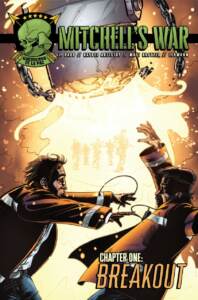By Jim Bado
Receiving feedback can be a powerful tool for improving yourself, your business and ESOP stock value. But, when done incorrectly, it can be powerfully destructive. A good feedback loop is part of healthy employee-owner engagement, effective committees and making improvements. The challenge for all of us as employee owners: being open to feedback to gain the upsides.
Here are some practical lessons for any employee owner from my real-world experience struggling to receive feedback on my personal project: the first employee-ownership comic book tale, Mitchell’s War.
Lesson 1: Ask for it
To develop Mitchell’s employee-ownership story, I’ve participated in workshops on writing and drawing comic books. Eventually, it was time to share my “baby” with others and ask for feedback in my online class. Just like an ESOP company striving to improve itself and its products or services, you need to ask for the perspective of others. Don’t expect people to volunteer their feedback.
Lesson 2: Listen and avoid knee-jerk defensiveness
During the review discussion of my comic book’s colored cover, I came close to turning off my camera so people didn’t see my face contorting into a frown. Given all the time, effort and energy put into the cover, I felt primed to punch someone by the end of the discussion.
Rather than give in to the knee-jerk reaction to get defensive, I took a deep breath and tried to listen. No one likes to hear their hard work critiqued or listen to where their effort falls short. But, instead of closing our ears, we ought to open them as wide as possible, disengage our mouth and actively listen. Wait a moment for your heart rate to go down, breathe again and imagine for a minute that this could be the nugget of information that unlocks a new plateau of success for you. This is when the magic of improvement starts to happen.
Lesson 3: Ask follow-up questions
Once you’ve listened, ask follow-up questions. Not something sarcastic like, “Where do you get off criticizing me?” But queries designed to clarify what the other person has said and to specifically understand how you can improve. After struggling to hear the feedback on my comic book cover, I asked our instructor how he would design it differently. He responded by illustrating on screen his approach. That opened my eyes to a new way of seeing things, which was extremely valuable. It happened because I listened and asked for clarification. Of course, I had that fight-or-flight physical reaction: sweaty palms, accelerated heart rate, and racing thoughts of defending my position. By setting those feelings in a parking lot in my mind for a moment, I collected great information. The same thing will happen in your company if you listen first and then ask follow-up questions.
Lesson 4: Thank people willing to give you feedback
The illustrator, colorist and letterer working on Mitchell’s War have all made suggestions for how to improve my story. Regardless of whether or not I implemented their suggestions, I always thanked them for their honest feedback because one never knows where the next great idea will originate.
Apply this at your company by remembering to say thank you to any employee who cared enough to share their feedback. It takes courage to speak up, which is something we as receivers of feedback often forget. As hard as this may sound, remember to recognize what it’s like to be in the giver’s shoes — the individual sharing their comments is taking as much of a risk as you are. People who are willing to give honest, fair, constructive feedback are rare and should be treasured. Assume the best intention and you may be surprised. Those with less-than-positive intentions will learn that feedback doesn’t derail you; it just makes you more effective. Thanking someone does not mean you agree with their suggestion. Thanking your fellow team members builds a culture of respect and trust that will lead to more employees at all levels thinking and acting like owners for the benefit of the company.
Lesson 5: Create and nurture a culture of receiving feedback
When you write a comic book script, you describe the action, but the illustrator brings it to life with their own ideas, perspectives, and experiences. In fact, the illustrator on Mitchell’s War suggested an alternative ending for the comic book. Her idea created a completely new, and better, conclusion that was adopted into the final version of our tale.
Things like that will never happen in your company without an environment where feedback is listened to and appreciated. In a competitive marketplace, culture and innovation are the keys to success; not providing someone with real feedback is detrimental to your company’s growth, profitability and future ESOP stock value. In an ESOP company, we all have a vested interest in helping each other succeed. Creating a safe environment where people can challenge ideas leads to better decisions and business results.
Whether you’re a manager or entry-level employee, you can adopt these suggestions to encourage others to give and receive feedback and to cherish each other’s ideas. Because if you can see feedback as helping you evolve and grow, then you’re on the road to success, whether you’re creating the first employee-ownership comic book tale or building a successful ownership culture.
****
Workplace Development provides communication, training and coaching to help you enhance your ownership culture. Please contact (330) 899-7100 to discuss your situation and how we might work together to make the most of your ESOP.
Want to learn more about Mitchell’s War? Follow along on LinkedIn as Jim searches for a publisher for this unique comic book tale. https://www.linkedin.com/company/mitchell-s-war/


